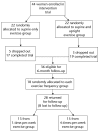Continence and quality-of-life outcomes 6 months following an intensive pelvic-floor muscle exercise program for female stress urinary incontinence: a randomized trial comparing low- and high-frequency maintenance exercise
- PMID: 18820095
- PMCID: PMC2599795
- DOI: 10.2522/ptj.20070257
Continence and quality-of-life outcomes 6 months following an intensive pelvic-floor muscle exercise program for female stress urinary incontinence: a randomized trial comparing low- and high-frequency maintenance exercise
Abstract
Background and objectives: Few studies have examined the effectiveness of pelvic-floor muscle (PFM) exercises to reduce female stress urinary incontinence (SUI) over the long term. This study: (1) evaluated continence and quality-of-life outcomes of women 6 months following formalized therapy and (2) determined whether low- and high-frequency maintenance exercise programs were equivalent in sustaining outcomes.
Subjects and methods: Thirty-six women with SUI who completed an intensive PFM exercise intervention trial were randomly assigned to perform a maintenance exercise program either 1 or 4 times per week. Urine leaks per week, volume of urine loss, quality of life (Incontinence Impact Questionnaire [IIQ] score), PFM strength (Brink score), and prevalence of urodynamic stress incontinence (USI) were measured at a 6-month follow-up for comparison with postintervention status. Parametric and nonparametric statistics were used to determine differences in outcome status over time and between exercise frequency groups.
Results: Twenty-eight women provided follow-up data. Postintervention status was sustained at 6 months for all outcomes (mean [SD] urine leaks per week=1.2+/-2.1 versus 1.4+/-3.1; mean [SD] urine loss=0.2+/-0.5 g versus 0.2+/-0.8 g; mean [SD] IIQ score=17+/-20 versus 22+/-30; mean [SD] Brink score=11+/-1 versus 11+/-1; and prevalence of USI=48% versus 35%). Women assigned to perform exercises once or 4 times per week similarly sustained their postintervention status.
Discussion and conclusion: Benefits of an initial intensive intervention program for SUI were sustained over 6 months. However, only 15 of the 28 women provided documentation of their exercise adherence, limiting conclusions regarding the need for continued PFM exercise during follow-up intervals of <or=6 months.
Figures
References
-
- Kegel AH. Progressive resistance exercises in the functional restoration of the perineal muscles. Am J Obstet Gynecol. 1948;56:238–248. - PubMed
-
- Burns PA, Pranikoff K, Nochajski TH, et al. A comparison of effectiveness of biofeedback and pelvic muscle exercise treatment of stress incontinence in older community-dwelling women. J Gerontol. 1993;48:M167–M174. - PubMed
-
- Henalla SM, Hutchins CJ, Robinson P, et al. Non-operative methods in the treatment of female genuine stress incontinence of urine. J Ob Gyn. 1989;9:222–225.
-
- Goode P, Burgio KL, Locher JL, et al. Effect of behavioral training with or without pelvic floor electrical stimulation on stress incontinence in women: a randomized controlled trial. JAMA. 2003;290:345–352. - PubMed
Publication types
MeSH terms
Grants and funding
LinkOut - more resources
Full Text Sources
Medical


